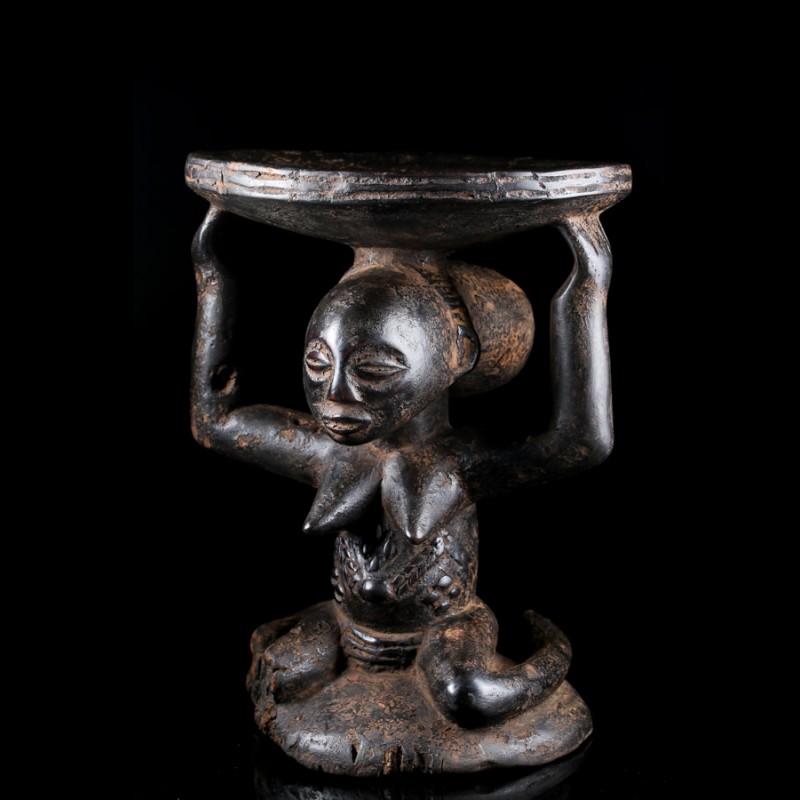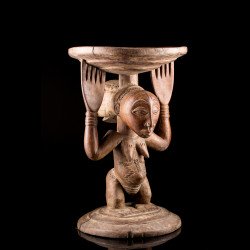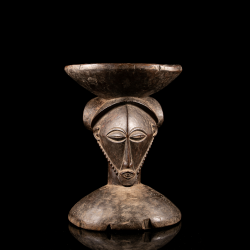



















An unusual wooden Luba stool with excellent, dark patina. The body of the stool is carved as a caryatid female with smooth features to the face characterized by the large, half closed eyes. The hair is pulled back to form a cone shape to the back of the head. To the top of the head is the shallow, bowl shaped seat. The arms are uplifted to support the seat. the body is solidly carved with prominent pointed breasts, and the area of the stomach is carved to show scarification marks. The legs are splayed on the oval base.
This type of stool is not meant to be sat upon, but rather acts as a symbolic expression of power for a deceased chief. They also act as a form of ancestral memory for that particular deceased chief as part of the ancestor worship that forms such an important part of Luba society. These memorial stools always have the figure of a female supporting the seat, and they are carved so as to represent the Luba concept of ideal, female beauty. Women in Luba society are believed to be the receptacles of spiritual power, and so these figures act as the embodiment of the power of the chiefs.
In the past, Luba chiefs came to power through a rigorous investiture process. The transgression of taboos was the basis for this. This involved seclusion in a ritual hut where they had to commit incest with a female relative, sleep in the presence of chiefs' relics, and drink human blood from the dried skulls of their predecessors. Blood was the agent that activated the new reign and linked to the terrifying power of the ancestors. This rite, called 'kutomboka', sanctified the privilege of leadership (Sources: Sendwe 1955; Van Avermaet and Mbuya 1961). These seats played a crucial role in the investiture rites. The seat was placed on a leopard skin. Photos of a seat from my collection. Given their importance, these seats were often hidden in villages other than that of the chief in question, because if an opponent could seize them, he would lose his power....
Data sheet
You might also like

An unusual wooden Luba stool with excellent, dark patina. The body of the stool is carved as a caryatid female with smooth features to the face characterized by the large, half closed eyes. The hair is pulled back to form a cone shape to the back of the head. To the top of the head is the shallow, bowl shaped seat. The arms are uplifted to support the seat. the body is solidly carved with prominent pointed breasts, and the area of the stomach is carved to show scarification marks. The legs are splayed on the oval base.
This type of stool is not meant to be sat upon, but rather acts as a symbolic expression of power for a deceased chief. They also act as a form of ancestral memory for that particular deceased chief as part of the ancestor worship that forms such an important part of Luba society. These memorial stools always have the figure of a female supporting the seat, and they are carved so as to represent the Luba concept of ideal, female beauty. Women in Luba society are believed to be the receptacles of spiritual power, and so these figures act as the embodiment of the power of the chiefs.
In the past, Luba chiefs came to power through a rigorous investiture process. The transgression of taboos was the basis for this. This involved seclusion in a ritual hut where they had to commit incest with a female relative, sleep in the presence of chiefs' relics, and drink human blood from the dried skulls of their predecessors. Blood was the agent that activated the new reign and linked to the terrifying power of the ancestors. This rite, called 'kutomboka', sanctified the privilege of leadership (Sources: Sendwe 1955; Van Avermaet and Mbuya 1961). These seats played a crucial role in the investiture rites. The seat was placed on a leopard skin. Photos of a seat from my collection. Given their importance, these seats were often hidden in villages other than that of the chief in question, because if an opponent could seize them, he would lose his power....

